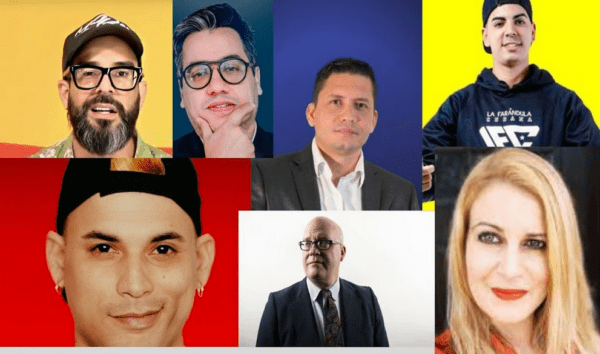The Cuban Government’s Terrorist List

By Francisco Acevedo
HAVANA TIMES – Nothing has caused a stir this week like the publication of Resolution 19/2023 by the Ministry of Interior (MININT) in the Cuba’s Official Gazette, last Thursday. It indicates the National List of People and Entities that have been subjected to criminal investigations and are wanted by the Cuban authorities, because of their involvement in the promotion, planning, organization, funding, support, or commission of acts unfolding in Cuba or in other countries.
The list includes people accused of being offenders of terrorist activities against Cuba from 1999 up until today and adds media and social network personalities from the Cuban community living in the US for inciting sedition and disorder, bringing the total number the Cuban Government is accusing of sponsoring terrorism to 61 individuals and 19 entities.
The first names belong to those who have open legal cases linked to attacks against hotels and other holiday resorts in Havana, infiltration along the coast to carry out violent acts, attacks against the President and other public servants, as well as those who have encouraged military action against Cuba.
It’s interesting that the list added people for inciting, organizing, and financing actions that disrupt the social order in Cuba, via violents acts against public servants and the normal functioning of institutions, and this is where several influencers based in Miami come into the picture, the most famous being: Alexander Otaola, Eliecer Avila, Manuel Milanes, Alain Lambert (Paparazzi cubano) and Jorge Ramon Batista (Ultrack).
Apparently, the legal grounds of this resolution are in keeping with the UN Security Council’s Resolution 1373, which is linked to preventing and fighting terrorism and financing of terrorism; the Cuban Penal Code; as well as Decree-Law 317 from the Council of State and MININT’s Resolution 16, to identify and tackle asset laundering and terrorist financing of crimes, the rapid spread of arms and illegal capital flight.
However, in addition to the striking fact that anyone who spreads an idea is considered a terrorist, there are also shady legal loose ends in this resolution.
For starters, this is nothing but our dear Miguel Diaz-Canel’s Government’s response to once again being featured on the US’ state sponsors of terrorism list.
First Colonel Moraima Bravet Garofalo, Chief of MININT’s Directorate for Criminal Investigations, who signed Resolution 19/2023, made the names of every individual and entity included on this list by the Cuban regime public.
Speaking in front of the Cuban government’s TV cameras, the official pointed out that these citizens “are wanted by the Cuban authorities,” which clearly means that they will never be able to step foot on the island again without facing jailtime, and even though nearly every single one of them has repeatedly said they won’t return to Cuba as long as the dictatorship remains in power, this is the first time that a resolution of this nature has been made public.
“Duly documented evidence” exists, and this is known in the case of violent acts, but they were never used against anyone sitting in front of a microphone.
Let’s not forget that Bravet Garofalo appeared three days after the historic July 11, 2021 protests in Cuba, on a special show by pseudo-journalist Humberto Lopez, to scare protestors, accusing them of different crimes, including incitement for just shouting “Patria y Vida” (Homeland and Life).
There’s a reason the Foundation for Human Rights in Cuba includes her on their list of “repressors”, as she is also considered responsible for the injustice committed by the regime against more than a thousand prisoners of conscience who have been locked behind bars for solely exercising their right to protest and free speech on that historic day.
Going back to Resolution 19/2023, this is nothing but an intimidation tool and the totalitarian Cuban regime’s new repressive method, which seeks to dismantle independent civil society acts by scaremongering.
It’s interesting to see how criminal offenders are being mixed up with media personalities, who no Cuban on the island should be afraid of, except for those who live with all of their privileges, because they’re afraid to lose them. I’d even dare to say that most Cubans respect them and the greatest proof of this is all of the money (translated in megas) which they spend on following their livestreams, live or a couple of hours later.
It’s clear that the Cuban Communist Party’s repressive state apparatus recognizes the power the independent media personalities hold to bring Cubans out of the dark on political matters. This fills them with dread, because the Cuban TV News and Granma newspaper were practically Cubans’ only source of information on this island, for decades.
If shouting “Patria y Vida” is a crime, we’re surrounded by terrorists, and in the case of these social media voices, recognition is being given to the work they do, they are the stone in the dictatorship’s shoe, regardless of the moral, legal and political implications of this measure to categorize them as terrorists.
The latter is also important; in fact, by taking the UN’s Resolution 1373 as a precedent, they want other countries to label them terrorists, even if they haven’t directly taken part in a crime, and this means freezing their funds, not granting them political asylum, and trapping them for good until they are even forced to be extradited.
Without proof, in these last cases, the least they can expect is protocols to hinder their stay ouside the US. To be honest, the countries are asking for evidence to take action, but even if in the end nothing happens, it would be advisable that they stay away from countries like China, Russia, Iran or Venezuela, for example.
We’ve reached the point where ideas are a crime in Cuba, even those spread from other places, but it’s clear as day that the Government is panicking, it’s the traditional kicking and fighting of the dying.





